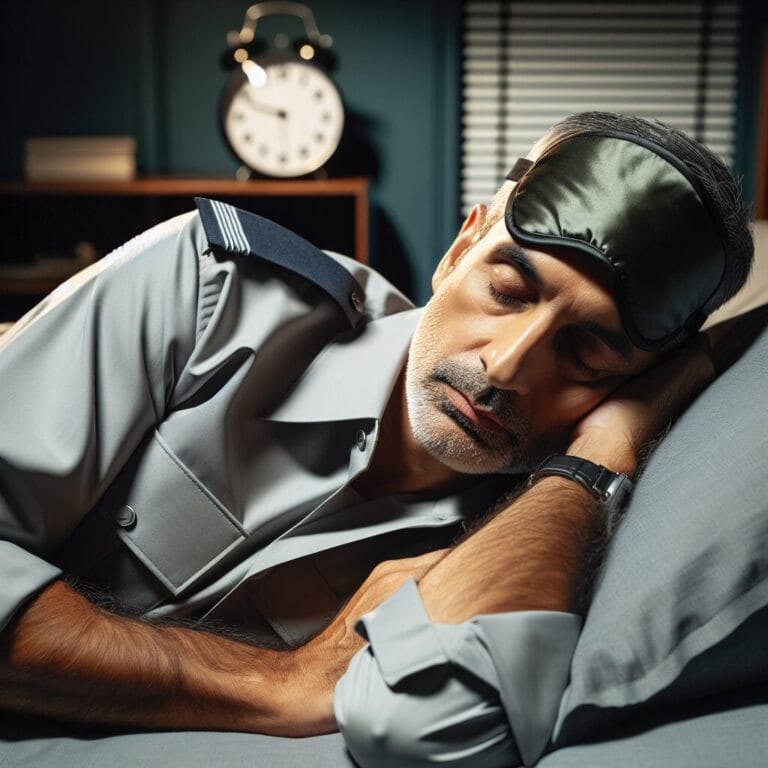
Better Rest for the Restless: Sleep Optimization Tips for Middle-Aged Adults with Night Shifts or Irregular Hours
Table of Contents
- Introduction
- Understanding Sleep Patterns
- Preparing for Better Sleep
- Dietary Considerations for Improved Sleep
- Sleep Schedules and Consistency
- Managing Stress and Anxiety
- Exercise and Physical Activity
- Technology and Sleep Aids
- When to Consult a Sleep Specialist
- Conclusion
- Frequently Asked Questions
Introduction
Hey there, night owls and sunrise warriors! Did you know that our internal clocks are like tiny master conductors, orchestrating the symphony of our sleep-wake cycle? But for those amazing folks who flip the script and work night shifts, the rhythm can get a bit wonky. So here’s the inside scoop: if you’re a shift worker, tweaking that circadian beat is key to snagging some sweet Zzzs. Imagine creating a sleep haven—cozy room light just dim enough to signal your brain it’s snooze o’clock. And what about a pre-bedtime ritual as regular as your favorite TV show? It’s all about setting the stage to tell your body “Hey, let’s slow down now.” Plus, throw in some cool-down physical activity earlier in the day—nothing too wild close to bedtime—and you’re on track for dreamland success. Steering clear of those tempting caffeinated drinks well before hitting the hay helps, too! Last but not least, consider chatting with a sleep specialist—they’re like detectives for dozing off—who can help tailor your slumber plan so you wake up feeling more superhero than sleepyhead.

Understanding Sleep Patterns
Did you know that the moon has a snooze button? Well, not exactly, but for night shift workers, figuring out how to get quality shuteye during the day can feel just as mythical. The thing is, when you work against the sun, your internal clock and the outside world are in a bit of a tiff. Circadian rhythms—that’s science talk for your body’s natural timer—get all mixed up when light exposure happens at odd hours. This circadian disruption can lead to shift work disorder, leaving even the most tireless night owl struggling to stay awake or fall asleep at the right times.
Think of melatonin supplements as little helpers whispering “time to sleep” when it’s bright outside. They could give that extra nudge towards dreamland during daylight hours, especially since our own melatonin production takes a hit with age and increased light exposure. Older adults already face an uphill battle with sleep quality and duration; throw in some night shifts and it’s like trying to canoe upstream without a paddle.
But here’s a pro tip: syncing your sleep schedule isn’t just about when you hit the pillow—it’s also about regular wake-up times. Consistency is key! And before you protest about missing afternoon BBQs or sunny picnics, consider this: aligning your sleep routine with your shift schedule might mean more energy for those weekend outings—you won’t be nodding off into your burger!
While excessive sleepiness begs for coffee by the gallon, resist the urge! Drink caffeinated beverages sparingly if you want to avoid staring at the ceiling come bedtime. Instead, let physical activity be your energizer bunny—just make sure it’s earlier in the day so you’re not too revved up before bed.
Last on today’s menu of midnight musings: room light tweaks. Invest in blackout curtains thicker than grandma’s lasagna or try eyemasks sleeker than superhero gear; anything that tells your peepers it’s not party time yet. So there you have it—tackle that shift work like a chess game and outsmart those sleepy pawns with strategic moves from dusk till dawn!
Preparing for Better Sleep
You might not think your mattress is a sleep superhero, but for shift workers, it’s the secret lair where all the magic happens. To improve sleep quality and battle against poor sleep linked to night shift work, it’s crucial to create a fortress of tranquility in your bedroom. Older adults working erratic hours need an oasis that whispers “relax” rather than one that screams “snooze button warfare!”
Let’s talk about setting up that perfect nest—the kind that cradles you into slumber. Start by investing in a mattress that supports your back like a trustworthy sidekick and pillows fluffier than clouds in a cartoon sky. The comfort of your bed can’t be overstated; it’s the springboard to dreamland! And what about those pesky beams of light sneaking through the blinds? Blackout curtains are the caped crusaders here, keeping your room shadowy and serene even when the sun is high.
Now, journeying into dreamland also means having pre-sleep rituals—your very own chill-out charade that signals to your internal clock it’s time to power down. Whether it’s sipping on herbal tea instead of caffeinated drinks or dabbling in some gentle yoga poses, find what lulls you towards those zzz’s.
But hey, let’s not forget nighttime noise—it’s like an arch-nemesis for sleep! Earplugs or white noise machines can keep those villainous sounds at bay. Imagine waves crashing or leaves rustling as nature sings you a lullaby.
And if tossing and turning become routine rather than rare? It might be time to call in reinforcements from sleep medicine – perhaps consult with a sleep specialist who can help tailor strategies unique as your dreams.
So there you have it: optimize light exposure with blackout heroes (curtains), ensure bedding feels like cloud nine, embrace calming pre-sleep habits over stimulating screen time, fight noise disturbances with soothing soundscapes, and reach out for expert advice if needed. This isn’t just bedtime; this is crafting a ritual fit for a knight—and you’re the knight facing the dragon of circadian disruption head-on!
Dietary Considerations for Improved Sleep
Picture this: You’re a valiant night shift worker, on a quest to conquer sleep in broad daylight. Now, let’s talk about the secret potions and elixirs—foods and drinks—that can be your allies or foes on this adventure. Beginning with the mighty beans of energy, coffee seems like a trusty sidekick, right? But hold up! Drinking caffeinated beverages too close to your slumber-time can turn them into pesky villains, keeping you wide-eyed when you need to fall asleep.
So what’s the good stuff that helps your eyelids get heavy? Cherries are packed with natural melatonin supplements, and sipping on cherry juice might just be like picking up a power-up for your sleep routine. Then there’s warm milk—a classic lullaby in a glass—which may remind your internal clock of cozier times and help signal it’s time to wind down.
Now, navigating through snacks and meal timings is as crucial as following a treasure map. Eating heavy meals right before bed can make you feel like you’re wrestling an octopus under the covers—not fun! To keep sleep problems at bay after night shifts, try to have a lighter snack if you’re peckish before hitting the pillow. And consider munching on almonds or walnuts; they’re like little knights guarding your sleep kingdom with their bounty of sleep-friendly magnesium and tryptophan.
As for timing? Aligning meals with your circadian rhythm can mean avoiding heavy armor (big meals) when you head into battle (sleep), especially important since eating late can lead to circadian disruption. A small snack is okay if you’ve got the late-night nibbles—just make sure it’s more like a scout than an entire cavalry.
Remember dear shift warriors, while caffeine might seem like your trusty steed by day, ease off its back as nighttime approaches. Embrace snacks that soothe rather than stir so when it’s time for rest, poor sleep quality won’t stand a chance against your well-prepared arsenal. Keep these drink and dine strategies in mind alongside room light tweaks and consistent wake-up times; together they form the ultimate fellowship for better shut-eye no matter what hours you work!
Sleep Schedules and Consistency
Imagine being a night shift worker navigating the ever-shifting seas of sleep schedules, where your internal clock often feels like it’s swinging to the tune of an unpredictable pendulum. This is where adapting to changing shift patterns becomes an art form. To maintain shipshape sleep quality amidst these fluctuating tides, consider treating naps like precious gems—use them wisely, and they’ll be your treasure; overdo them, and you risk a mutiny in your nocturnal rhythm.
Here’s the deep dive on napping: short power naps can be a lifeline, about 20 minutes or so, enough to sharpen your focus but not so long that you fall into the deeper waters of sleep inertia. Steer clear of long snoozes close to your planned bedtime; these can sweep away any hopes of nighttime slumber faster than a rogue wave.
For those committed to their lunar labor with heart and soul as night shift workers face an increased risk for circadian disruption. To counter this, develop a steadfast alliance with consistency—same wake-up time, same bedtime, even on days off if possible. Your body’s internal clock thrives on routine like ships rely on stars for navigation.
Physical activity also walks the plank here—exercise regularly but dock those workouts several hours before you drop anchor for bed. This gives your adrenaline levels time to ebb away gently before you attempt to sail into dreamland.
And let’s hoist one more idea up the mast: consult with a sleep specialist if high seas keep hitting your slumber ship despite all efforts. These captains of sleep medicine can help chart a course tailored just for you; they’re like navigators finding passage through turbulent waters.
So remember, mateys: balance short naps with wisdom, pledge allegiance to regularity in your wake-up time and bedtimes irrespective of shifts, invite physical activity aboard but not too late in the day, and when in doubt, seek out those skilled guides—sleep specialists—to lead you safely back to the haven of restorative rest.
Managing Stress and Anxiety
Shift workers often find themselves battling more than just the odd hours of their night shifts; they’re up against stress and anxiety, which can be like sneaky gremlins mucking up the gears of their internal clocks. It’s not all doom and gloom, though—if you’ve got a wonky work schedule, managing stress is your secret weapon for conquering sleep problems. Exercise isn’t just great for keeping you fit; it also acts like a spell to cast out stress, leaving you calmer when it’s time to fall asleep. Now imagine pairing that with relaxation techniques: deep breathing or even a cozy meditation session can act like a lullaby for your overworked brain.
Here’s where things get super interesting—sometimes the dragon of sleeplessness is too fierce to tackle alone, and that’s perfectly okay! If excessive sleepiness is turning into an unwelcome roommate or if the sandman seems to be on a permanent vacation despite your best efforts, seeking professional help might just be the key. Sleep medicine wizards—aka sleep specialists—are ace at untangling these knots. They’re pros at crafting bespoke strategies that fit snugly into your unique shift schedule.
So when counting sheep turns into counting worries, remember that tools like physical activity and tranquility techniques are as mighty as any sword. And if your fortress still gets breached by stress-induced insomnia? Rallying the troops in the form of expert support may just turn the tide in your favor for restorative slumber.
| Aspect | Details | Benefits |
|---|---|---|
| Work Schedule | Shift workers with irregular night shifts | Understanding and managing unique stressors and sleep issues |
| Exercise | Regular physical activity | Reduces stress, promotes calmness, improves readiness for sleep |
| Relaxation Techniques | Deep breathing, meditation | Acts as a lullaby for the brain, easing into sleep |
| Professional Help | Consulting sleep specialists or seeking sleep medicine | Provides tailored strategies for sleep issues related to shift work |
| Mental Strategies | Physical activity and tranquility techniques | Combat stress and insomnia, leading to restorative sleep |
Exercise and Physical Activity
For night shift heroes looking to combat the villainous sleep problems, turning into an exercise ally is like discovering a superpower for snooze success. Engaging in regular physical activity not only strengthens your body but also helps tire out those buzzing thoughts when bedtime battles roll around. Now, not all exercises are created equal for our sleep-seeking shift workers; some pump you up while others wind you down. Opting for calm, steady activities such as walking or yoga can be as soothing as a sunset, telling your hardworking body it’s time to ease into night mode.
Timing is everything! Just like you wouldn’t start a movie marathon right before bed (cause who can stop after just one?), knowing when to lace up those sneakers is crucial. Morning or early evening workouts strike that perfect balance—boosting energy when you need it and allowing calm to creep back before it’s time to hit the hay. Plus, timing exercise correctly keeps your circadian clock ticking like a well-oiled machine despite the topsy-turvy world of shift work.
So there we have it—mix in some mellow movement with your daily grind and watch how it lifts the fog of fatigue. A little sweat might just pave the way for sweet dreams, making that elusive quality sleep less of a mirage and more of a nightly visit from sandman himself!
Technology and Sleep Aids
Shift workers, behold the age of technology where gadgets and apps stand guard over your slumber. Imagine strapping on a sleep tracker, a nifty wrist-bound sidekick that monitors the ebbs and flows of your rest. These digital champions log everything from heart rates to tossing and turning, painting a picture of your nighttime narrative. By understanding these patterns, you can fine-tune your sleep routine in tune with the rhythm of night shifts, making sure every precious moment of shut-eye counts.
Now let’s chat about white noise machines—silent heroes that mask disruptive sounds with soothing soundscapes like rainforest showers or ocean waves. These devices are like having a personal lullaby composer by your bedside, creating an ambient soundtrack to drown out the chaos. Perfect for those whose slumber is frequently sabotaged by random rackets or room light intrusions.
But when do you call upon additional sleep aids? If counting sheep feels like herding cats and melatonin supplements have taken center stage on your nightstand, it’s wise to discern their role in your twilight tango. While occasional use can nudge you towards the land of nod, reliance isn’t ideal. A powwow with a sleep specialist might shed light on whether these aids should be guest stars or regular cast members in the drama that is shift work sleep.
Whether harnessing tracker data to tweak timings, summoning white noise for acoustic armor, or judiciously judo-flipping into sleep aids—each strategy holds power to improve sleep despite demanding schedules. After all, when you clock out from the nocturnal grindstone and slide under the sheets, ensuring quality rest isn’t just a dream; it’s a mission possible!

When to Consult a Sleep Specialist
Ever tossed and turned at night, wondering if your sleep woes need a superhero in the form of a sleep specialist? Here’s a little nudge to help you identify those bat signals in the sky. If your night shift work has you seeing more sheep than dreams, or if no amount of room light tweaking and caffeine dodging is helping you fall asleep, it might be time to call in the experts. When excessive sleepiness turns into an unwanted shadow during your day or poor sleep quality becomes your nightly nemesis, these are clear signs that a professional might need to step into your circadian rhythm conundrum.
So, what happens when you decide to visit this guardian of nocturnal peace? Picture this: A comfy office where you’ll spill the beans about your snooze troubles—everything from your erratic shift schedule to how often you stay awake staring at the ceiling. Don’t be shy; they’ve heard it all! Your sleep medicine maestro will likely inquire about your daily habits, from physical activity to that sneaky late-night snack. They’re piecing together clues like a detective solving The Case of the Elusive Slumber.
And fear not—the treatment options for shift work disorder and other mischievous sleep predicaments span far and wide. From behavioral therapy that coaches you through relaxation techniques fit for a Zen master to medications that gently coax your internal clock back on track, there’s hope yet! So next time slumber feels like a distant dreamland, remember that these specialists are just around the corner, ready to tailor a solution as unique as your own midnight musings.
Conclusion
Shift workers, listen up! You’re no strangers to the struggles of snoozing when the world tells you it’s time to be awake. But here’s something you might not know: your diet before a night shift can be as powerful as any superhero cape for combating sleep problems. Yep, what you munch on could be your secret ingredient to dreamland success. Instead of reaching for that slice of pepperoni pizza right before bed, why not choose tryptophan-rich foods like turkey or eggs? They’re like little ninjas fighting off insomnia. And those fizzy sodas and chocolate bars? They might seem like quick energy fixes, but they’re actually sneaky villains robbing you of restful slumber.
Let’s also shine some moonlight on hydration—water is your trusty sidekick keeping bodily functions in harmony while you sleep. Keeping well-hydrated ensures that when your head hits the pillow after a long night shift, every cell in your body is ready for rejuvenating rest. Oh, and if you’ve been battling with that bright room light after night shifts, consider red-tinted bulbs; they can trick your circadian clock into thinking the sun has set, even if it’s high noon outside!
Remember this dynamic duo for sleep victory—tasty nutrition choices and staying hydrated help keep circadian disruption at bay. Combined with consistent wake-up times and strategic light exposure management, these factors play a colossal role in ensuring that older adults working night shifts stay healthy and vibrant. With these strategies tucked under your pillow, bedtime becomes less of a battle and more of a welcome retreat into the land of nod.



